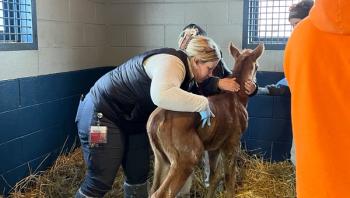
AAHA moves to streamline medical protocols
Denver — In a major push to streamline medical protocols, the American Animal Hospital Association (AAHA) is releasing a series of guidelines for veterinarians.
DENVER — In a major push to streamline medical protocols, the American Animal Hospital Association (AAHA) is releasing a series of guidelines for veterinarians.
Senior care guidelines for dogs and cats were unveiled at the association's annual conference in Baltimore. Dental care guidelines are scheduled for release this summer, while canine vaccine guidelines are expected to be updated in 2006.
"We feel it is critical to release guidelines for the profession to give a framework for practitioners to follow," says Dr. Daniel Aja, AAHA president. "The guidelines are composed by veterinarians and are for the general practitioner to use on a daily basis. It is very feasible as a veterinarian to want to use information given collaboratively by peers."
The senior-care guidelines advocate early detection of disease and describe common conditions and aspects of screening geriatric animals, diagnosis, treatment, pain management, anesthesia and surgery commonly performed on senior pets.
About 14 percent of owners comply with the suggested senior pet diagnostic tests, a strong argument for the necessity of implementing a protocol, Aja says. Ways to increase compliance also are noted to improve a veterinarian's ability to help pets.
"These guidelines are very detailed, citing numerous conditions that parallel with aging pets — weight issues are addressed as well as behavioral and psychological disorders," Aja says.
The directive also provides ways to evaluate an animal's quality of life to aid in the decision making process.
The guidelines feature ways to approach an apparently healthy senior pet, a sick senior pet, client communication, patient assessment and other topics. Charts include better descriptions on how to evaluate blood work, including additional assessments to perform based on results.
"The average age a pet is considered senior is 7,"Aja says. "There are specifications noted in the guidelines that addresses age/breed and status."
The task force was composed of seven veterinarians that represent a variety of specialty fields including:
- Mark Epstein, DVM, chair;
- Ned Kuehn, DVM, MS, Dipl. ACVIM;
- Gary Landsberg, DVM, Dipl. ACVB;
- B. Duncan X. Lascelles, Bsc, BVSc, PhD, MRCVS, Dipl. ECVS, diplomate ACVS;
- Steven L. Marks, MS, MRCVS, Dipl. ACVIM;
- Jean Schaedler, DVM, Dipl. ABVP (Canine/Feline);
- Helen Tuzio, DVM, Dipl. ABVP (Feline).
The guidelines were sponsored by an educational grant from IDEXX Laboratories.
Dental guidelines
Pending approval by the AAHA Board of Directors, dental guidelines are slated for publication this summer.
The guidelines are expected to provide DVMs with a standard of practice for companion animal dentistry, Aja says.
"Oral diseases can lead to serious disease," says Dr. Dennis Feinberg, immediate past president, AAHA. "These guidelines will serve as a resource to help practitioners provide the best possible dental care for their patients."
The dental guidelines task force was put together with the combined effort of Feinberg and Aja.
"The goal is to provide a minimum standard of companion animal dentistry. We want to set the standard for companion animal dentistry — defining what is appropriate for the general veterinarian: patient assessment by life stage, recommendations on the proper dental exam of a pet and other important information," Aja says.
"The guidelines are about 10 pages long and really define proper ways to better care for patient's dental needs."
The task force is composed of boarded professionals and include:
- Steven Holmstrom, DVM, AVDC, chair;
- Ben Colmery, DVM, AVDC;
- M. Lana Conway, DVM, FAVD, AVDC;
- Jan Bellows, DVM, ABVP, AVDC;
- Katherine Knutson, DVM;
- Jeanne Vitoux, CVT.
The guidelines were sponsored by a grant from Merial Limited.
Canine vaccine guidelines
The canine vaccine guidelines will be revised because of the addition of vaccines and removal of others from the veterinary market.
"The guidelines are 100 percent based on need, Aja says. "New information on vaccines has made the last update from two years ago, outdated," he adds.
Dr. Mike Paul, an AAHA past president, chairs the task force.
"AAHA really keeps on the cutting edge of veterinary medicine; the organization makes position statements on need to standardize microchipping and makes decisions in the best interest of pets and the profession," Aja adds.
Approval for senior guidelines came last October by the AAHA Board of Directors; the guidelines appear in the March/April issue of The Journal of the American Animal Hospital Association and Trends magazine.
Newsletter
From exam room tips to practice management insights, get trusted veterinary news delivered straight to your inbox—subscribe to dvm360.






